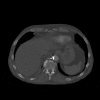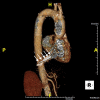Self-inflicted Cardiac Injury with Nail Gun Without Hemodynamic Compromise: A Case Report
- PMID: 28191375
- PMCID: PMC5298934
- DOI: 10.7759/cureus.971
Self-inflicted Cardiac Injury with Nail Gun Without Hemodynamic Compromise: A Case Report
Abstract
Pneumatically powered nail guns have been used in construction since 1959. Penetrating injuries to the heart with nail guns have a wide range of presentations from asymptomatic to cardiac tamponade and exsanguination. Mortality related to cardiac nail gun injuries is similar to knife injuries, estimated at 25%. Surgical exploration is the treatment of choice. We describe a case of self-inflicted nail gun injury to the chest without hemodynamic compromise in a 51-year-old man. Computed tomography (CT) imaging confirmed nail penetrating the right ventricle, with the tip adjacent to but not violating the abdominal aorta. The patient was successfully treated with thoracotomy and foreign body removal.
Keywords: cardiothoracic surgery; computed tomography; nail gun; penetrating chest injury; trauma.
Conflict of interest statement
The authors have declared that no competing interests exist.
Figures





References
-
- Cardiac nail gun injuries: lessons learned. Vosswinkel JA, Bilfinger TV. J Trauma. 1999;47:588–590. - PubMed
-
- Life-threatening nail gun injuries. Beaver AC, Cheatham ML. http://www.ncbi.nlm.nih.gov/pubmed/10597056. Am Surg. 1999;65:1113–1116. - PubMed
-
- Penetrating cardiac nail gun injury. Carr CS, Alkhafaji S, Alkhulaifi AM. Emerg Med J. 2008;25:313. - PubMed
-
- Images in clinical medicine. Nail in the aorta. Felner JM. N Engl J Med. 1996;334:239. - PubMed
-
- Images in cardiovascular medicine. Direct nail injury to the heart without functional or hemodynamic compromise. Georghiou GP, Birk E, Nili M, Stein M, Vidne BA, Erez E. Circulation. 2003;107:0–3. - PubMed
Publication types
LinkOut - more resources
Full Text Sources
Other Literature Sources
